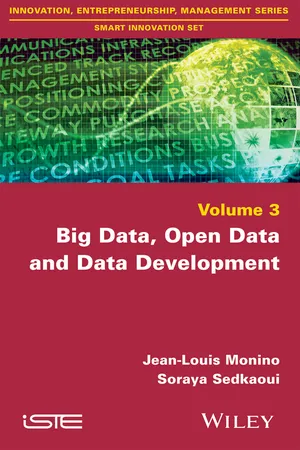
- English
- ePUB (mobile friendly)
- Available on iOS & Android
Big Data, Open Data and Data Development
About This Book
The world has become digital and technological advances have multiplied circuits with access to data, their processing and their diffusion. New technologies have now reached a certain maturity. Data are available to everyone, anywhere on the planet. The number of Internet users in 2014 was 2.9 billion or 41% of the world population. The need for knowledge is becoming apparent in order to understand this multitude of data. We must educate, inform and train the masses. The development of related technologies, such as the advent of the Internet, social networks, "cloud-computing" (digital factories), has increased the available volumes of data. Currently, each individual creates, consumes, uses digital information: more than 3.4 million e-mails are sent worldwide every second, or 107, 000 billion annually with 14, 600 e-mails per year per person, but more than 70% are spam. Billions of pieces of content are shared on social networks such as Facebook, more than 2.46 million every minute. We spend more than 4.8 hours a day on the Internet using a computer, and 2.1 hours using a mobile. Data, this new ethereal manna from heaven, is produced in real time. It comes in a continuous stream from a multitude of sources which are generally heterogeneous.
This accumulation of data of all types (audio, video, files, photos, etc.) generates new activities, the aim of which is to analyze this enormous mass of information. It is then necessary to adapt and try new approaches, new methods, new knowledge and new ways of working, resulting in new properties and new challenges since SEO logic must be created and implemented. At company level, this mass of data is difficult to manage. Its interpretation is primarily a challenge. This impacts those who are there to "manipulate" the mass and requires a specific infrastructure for creation, storage, processing, analysis and recovery. The biggest challenge lies in "the valuing of data" available in quantity, diversity and access speed.
Frequently asked questions
Information
1
The Big Data Revolution
1.1. Understanding the Big Data universe
- – Clouds, Big Data, and Smart Assets: Ten Tech-Enabled Business Trends to Watch [BUG 10];
- – Are You Ready for the Era of “Big Data”? [BRO 11];
- – Big Data: The Next Frontier for Innovation, Competition and Productivity [MAN 11].
- – Volume: the advent of the Internet, with the wave of transformations in social media it has produced; data from device sensors; and an explosion of e-commerce all mean that industries are inundated with data that can be extremely valuable. All these new devices produce more and more data, and in turns, enrich the volume of existing data;
- – Variety: with the rise of Internet and Wi-Fi networks, smartphones, connected objects and social networks, more and more diverse data is produced. This data comes from different sources and varies in nature (SMSs, Tweets, social networks, messaging platforms, etc.);
- – Velocity: the speed at which data is produced, made available, and interpreted in real-time. The possibility of processing data in real-time represents a field of particular interest, since it allows companies to obtain results like personalized advertisements on websites, considering our purchase history, etc.;
- – Value: the objective of companies is to benefit from data, especially by making sense out of it.
Table of contents
- Cover
- Table of Contents
- Title
- Copyright
- Acknowledgements
- Foreword
- Key Concepts
- Introduction
- 1 The Big Data Revolution
- 2 Open Data: A New Challenge
- 3 Data Development Mechanisms
- 4 Creating Value from Data Processing
- Conclusion
- Bibliography
- Index
- End User License Agreement